Saturday, June 04, 2005
Silvered Æ antoninianus, Gallienus, Siscia, Göbl 1511b
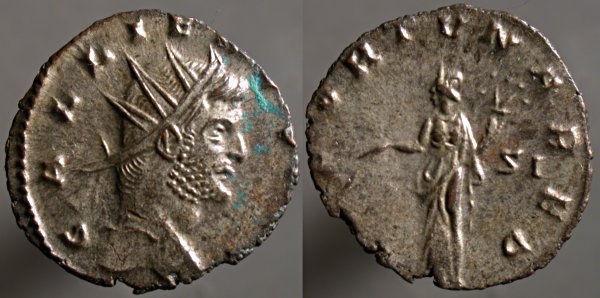
GALLIENVS AVG, Radiate head right | FORTVNA RED, Fortuna standing left, holding rudder on globe left, and overflowing cornucopia right. SI in right field.
Again, a sign of the flyspeck examination that characterizes dedication (or obsession?) in a collector: I already had an example of this more common coin, identical but for having the SI officina mark in the left field instead of the right.
Friday, June 03, 2005
Æ tetradrachm, Alexandria, Valerian, Emmett 3709(3)

A K Π ΛI OVAΛEPIANOC EVEVC, Laureate cuirassed bust right | LΓ, Elpis standing left, hitching skirt right, holding flower left. Regnal year across fields.
Here's a page about the representation of Spes, the Roman equivalent to Elpis, personification of hope, with the same iconography.
I think Alexandria was engraving a better Elpis/Spes at this time than the imperial mints were.
Thursday, June 02, 2005
Silvered Æ antoninianus, Gallienus, Rome, Göbl 614a
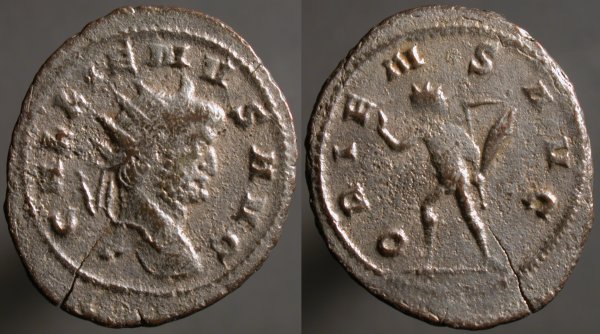
GALLIENVS AVG, Radiate head right | ORIENS AVG, Sol advancing left, raising hand left, holding whip right, cloak flying right.
Nice full-circle strikes on both sides, a bit flat at the reverse center, with a significant crack, silver mostly intact with some surface deterioration. All in all, a quite acceptable example of a fairly scarce version that lacks an officina mark, Göbl attests 18 of these with this bust. With shipping, I paid under $20, since no one else wanted it enough to pay more.
Supply matters, but demand drives the price of ancients in the same way it drives the price of land.
Wednesday, June 01, 2005
AR denarius, M. Papirius Carbo, Rome, 122 BCE, Crawford 276/1
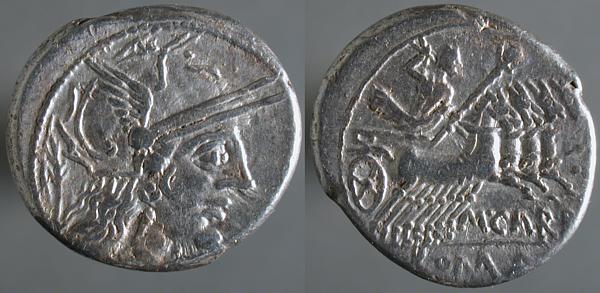
Helmeted head of Roma right, X below chin, branch behind | Jove in quadriga racing right, holding thunderbolt aloft left. M CARBO below, ROMA in exergue.
Gaius Gracchus, early social reformer, was tribune in 122 BCE, the year this was minted. His death didn't put an end to the rot, though, and soon enough the Roman public found they could use political force to take the property of others.
Recognizing the fall of the Republic was then just a matter of time.
Tuesday, May 31, 2005
Æ25, Thessalian Koinon, Gallienus, SNG Copenhagen 355var
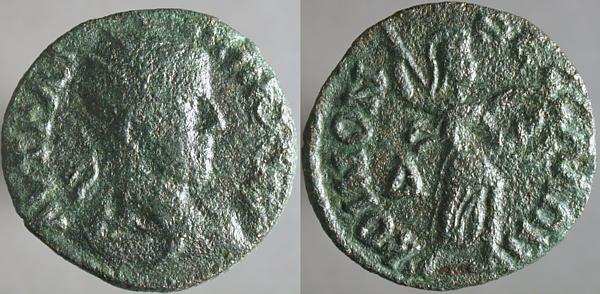
AYT ΓAΛ_[ΛNOVC], Radiate draped bust right | KOINON ΘECCAΛΩN, Athena, with aegis and spear, advancing right. Δ behind.
While most European provincial mints had shut down by the time of Gallienus's reign, Thessaly was still in operation.
This example is a bit different from this more common version, with a different bust and the words of the reverse legend ordered differently.
Monday, May 30, 2005
Æ antoninianus, Gallienus, Rome?, like Göbl 375xvar

IMP GALLIENVS P F AVG G M, Radiate cuirassed bust right | VIRTVS AVG, Mars standing facing, head left, holding spear right and shield left. VI in right field.
No question on this one, this is an ancient counterfeit:
Sunday, May 29, 2005
Æ29, Ephesus in Ionia, Gallienus, SNG Copenhagen 522var
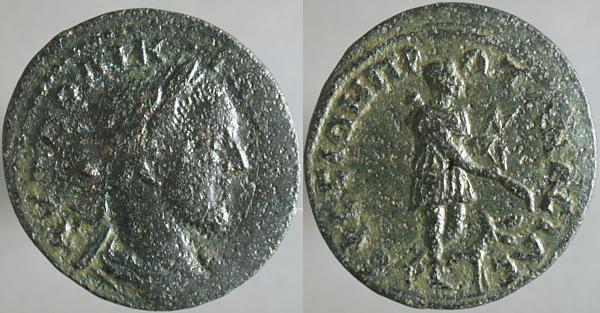
AVT K ΠO ΛIK ΓAΛ[...], Laureate draped bust right | EΦECIΩN ΠPOTON ACIAC, Artemis standing right, holding bow, arrow, and torch right, hound at feet, right.
ΠPOTON ACIAC proclaims Ephesus as the #1 city in Asia, which I suppose was reassuring to read if you lived there. Artermis was a popular subject for coins from Ephesus.

